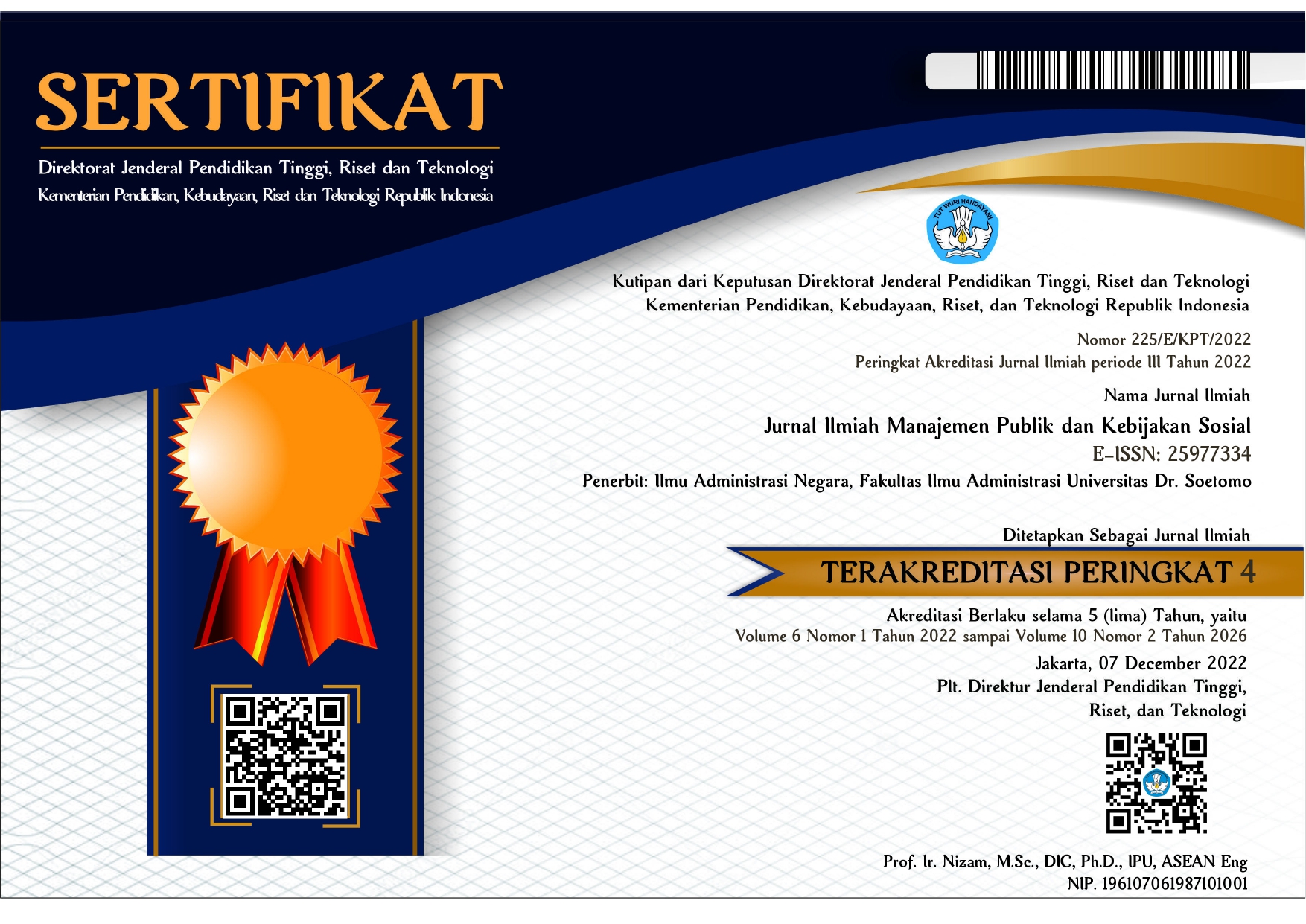Karakteristik Rumah Tangga Miskin Ektrem di Propinsi Jawa Barat
 Abstrak views: 386
,
Abstrak views: 386
,
 PDF downloads: 1020
PDF downloads: 1020
Abstrak
Tujuan dari penelitian ini adalah untuk mengetahui karakteristik kemiskinan ekstrem dan faktor yang mempengaruhinya di Propinsi Jawa Barat. Data yang digunakan dalam penelitian ini merupakan data mikro SUSENAS bulan Maret 2020, yang dikeluarkan oleh BPS. Metode analisis yang digunakan adalah regresi logistik biner. Variabel bebas dalam penelitian ini yaitu karakteristik rumah tangga yang terdiri dari jumlah anggota rumah tangga, kepemilikan asuransi kecelakaan, kepemilikan sertifikat rumah, serta tempat tinggal rumah tangga. Sedangkan variabel bebas lainnya terkait dengan karakteristik kepala rumah tangga, terdiri dari jumlah jam kerja, usia, pendidikan, status pernikahan, jenis kelamin, kemampuan baca tulis, penggunaan teknologi dan pemanfaatan internet. Sedangkan yang menjadi variabel terikatnya yaitu rumah tangga miskin ekstrem. Berdasarkan hasil penelitian, secara statistik jumlah anggota rumah tangga, kepemilikan asuransi kecelakaan, kepemilikan sertifikat rumah, tempat tinggal rumah tangga berpengaruh terhadap kemiskinan ekstrem. Karakteristik kepala rumah tangga yang terdiri dari jumlah jam kerja, usia, pendidikan, status pernikahan, jenis kelamin, kemampuan baca tulis, kepemilikan handphone serta akses terhadap internet secara signifikan berpengaruh terhadap rumah tangga miskin ekstrem. Oleh karena itu, untuk mengentaskan kemiskinan khususnya di Jawa Barat, diantaranya kebijakan pengendalian penduduk, penyediaan jaminan sosial, kemudahan pengurusan kepemilikan sertifikat rumah, serta pemeratan pembangunan hingga wilayah pedesaan. Sedangkan kebijakan pengentasan kemiskinan ekstrem dikaitkan dengan karakteristik KRT adalah menyediakan pekerjaan yang layak (decent jobs), peningkatan kapasitas rumah tangga melalui pendidikan dan pelatihan, serta memberikan peluang dan hak yang sama bagi perempuan untuk memasuki pasar tenaga kerja dengan upah yang sesuai.
Referensi
Akita, T., Made, N., & Dariwardani, I. (2013). Chronic and Transient Poverty in Indonesia : A Spatial Perspective based on the 2008-2010 Susenas Panel Data. 24530274.
Badan Pusat Statistik. (2019). Penghitungan dan Analisis Kemiskinan Makro Indonesia Tahun 2019 (Issue 1). https://doi.org/10.1007/s13398-014-0173-7.2
Badan Pusat Statistik. (2021). BRS.Profil Kemiskinan di Indonesia Maret 202.,No. 53/07/Th. XXIV, 15 Juli 2021.
Bappenas, K. P. P. N. (2018). Kedeputian Bidang Kependudukan dan Ketenagakerjaan Kementerian PPN/Bappenas.
Bayudan-Dacuycuy, C., & Lim, J. A. (2013). Family size, household shocks and chronic and transient poverty in the Philippines. Journal of Asian Economics, 29, 101–112. https://doi.org/10.1016/j.asieco.2013.10.001
Chambers, R. (1987). Pembangunan Desa Mulai Dari Belakang. LP3ES.
Esmara, H. (1986). Perencanaan dan Pembangunan di Indonesia. Gramedia.
Harlan, J. (2004). Metode Statistik 1 (1st ed.). Gunadarma.
Haughton, Jonathan & R.Khander, S. (2009). Handbook on Poverty and Inequality. World Bank.
Iskandar, A. (2012). Paradigma Baru Benchmarking Kemiskinan Suatu Studi ke Arah Penggunaan Indikator Tunggal. PT Penerbit IPB Press.
Kurniawan, R. (2019). Cara Mudah Belajar Statistik Analisis Data & Eksplorasi. Prenada Media.
Pangaribowo, E. H., & Tsegai, D. (2019). Women’s bargaining power and household expenditure in Indonesia: the role of gender-differentiated assets and social capital. GeoJournal, 84(4), 939–960.
Sayogyo. (1977). Garis Kemiskinan dan Kebutuhan Minimum Pangan. Pusat Studi Pembangunan Pertanian dan Pedesaan. LPPM-IPB.
Suryadi, D. (2021). Pengaruh Dinamika Tenaga Kerja Terhadap Dinamika Status Kemiskinan di Indonesia (Analisis Data IFLS).
TNP2K. (2021). Indikator Kesejahteraan Sosial Utama 35 Kabupaten Fokus Penanggulangan Kemiskinan Ekstrem Tahun 2021.
World Bank. (2020). Poverty And Shared Prosperity 2020, REVERSALS OF FORTUNE .
World Bank. (2021). Poverty and Equity Brief East Asia & Pasific.
World Bank Group. (2006). Era Baru dalam Pengentasan Kemiskinan di Indonesia (Ikhtisar). World Bank.
Yunus, H. S. (2016). Metodologi Penelitian Wilayah Kontemporer. Pustaka Pelajar.
##submission.copyrightStatement##
##submission.license.cc.by-sa4.footer##
Authors who publish with JIMPKS: Jurnal Ilmiah Manajemen Publik dan Kebijakan Sosial agree to the following terms:
-
Authors retain copyright and grant the journal right of first publication with the work simultaneously licensed under a Creative Commons Attribution License (CC BY-SA 4.0) that allows others to share the work with an acknowledgment of the work's authorship and initial publication in this journal.
-
Authors are able to enter into separate, additional contractual arrangements for the non-exclusive distribution of the journal's published version of the work (e.g., post it to an institutional repository or publish it in a book), with an acknowledgment of its initial publication in this journal.
-
Authors are permitted and encouraged to post their work online (e.g., in institutional repositories or on their website) prior to and during the submission process, as it can lead to productive exchanges, as well as earlier and greater citation of published work.










